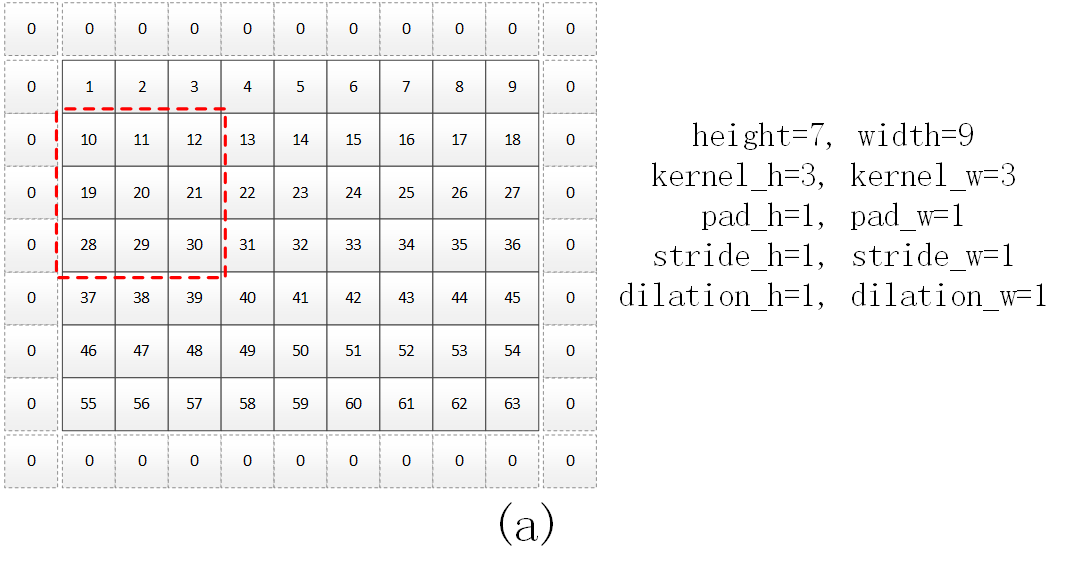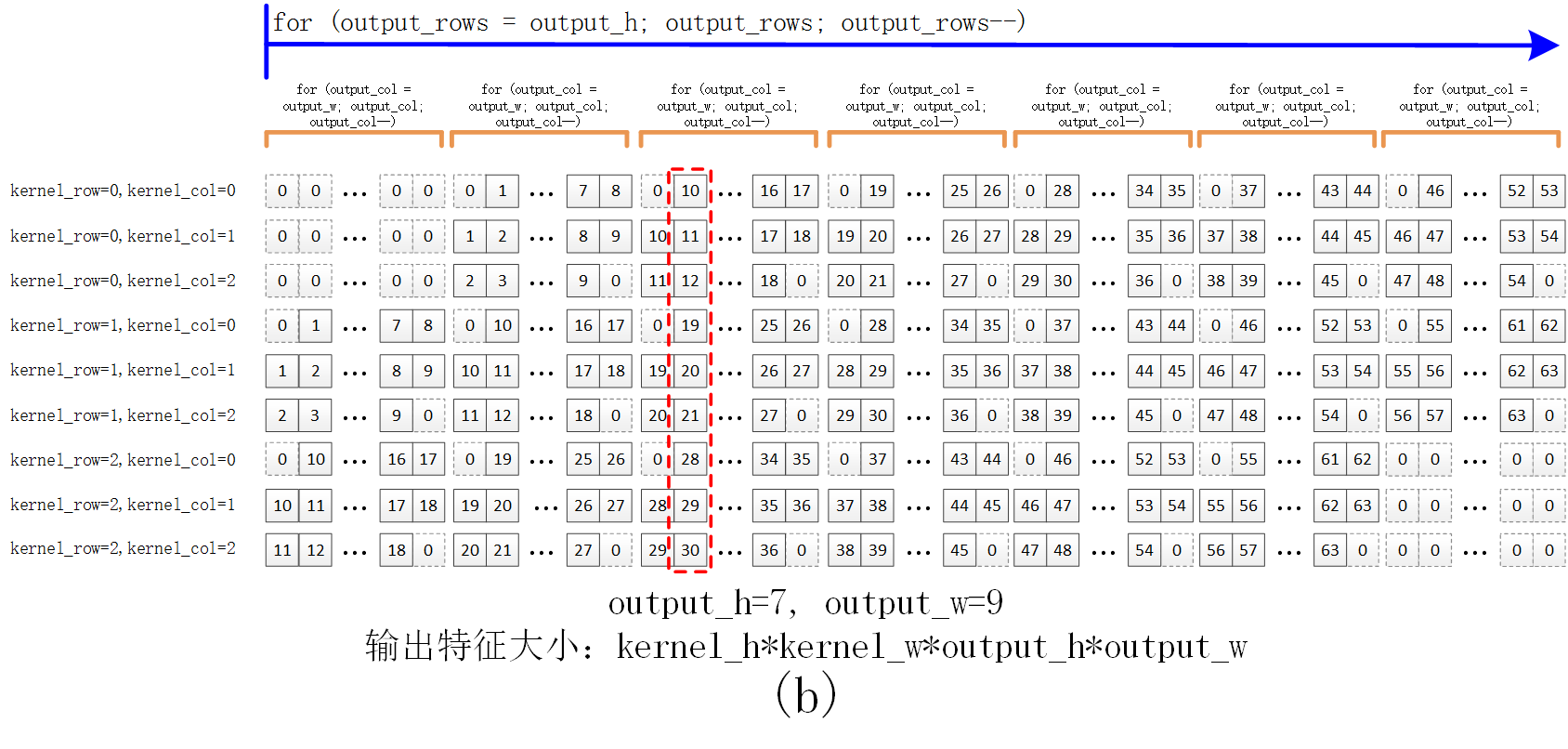(原)caffe中的conv
转载请注明出处:
https://www.cnblogs.com/darkknightzh/p/10486686.html
conv总体调用流程如下图所示:

说明:带o的为输出,如Wo代表输出宽度;带i的为输入,如Hi代表输入高度
1. 前向传播的计算ConvolutionLayer<Dtype>::Forward_cpu
注:不考虑反向传播的计算过程…
前向传播时,分别调用base_conv_layer.cpp中的BaseConvolutionLayer<Dtype>::forward_cpu_gemm和base_conv_layer.cpp中的BaseConvolutionLayer<Dtype>::forward_cpu_bias
template <typename Dtype>
void ConvolutionLayer<Dtype>::Forward_cpu(const vector<Blob<Dtype>*>& bottom,
const vector<Blob<Dtype>*>& top)
{
const Dtype* weight = this->blobs_[]->cpu_data(); // weight参数
for (int i = ; i < bottom.size(); ++i) { // 多少个输入。一般1个的比较常见吧
const Dtype* bottom_data = bottom[i]->cpu_data(); // 第i个输入:NCHiWi
Dtype* top_data = top[i]->mutable_cpu_data(); // 第i个输出:NCHoWo
for (int n = ; n < this->num_; ++n) { // batchsize
//forward_cpu_gemm输入为第n个channel的起始位置(C*Hi*Wi),及权重参数(No*Ni*Kh*Kw),输出为第n个channel的起始位置,(C*Ho*Wo)
this->forward_cpu_gemm(bottom_data + n * this->bottom_dim_, weight, top_data + n * this->top_dim_);
if (this->bias_term_) { // 含有bias
const Dtype* bias = this->blobs_[]->cpu_data(); // bias参数
this->forward_cpu_bias(top_data + n * this->top_dim_, bias); // 计算增加bias后的输出
}
}
}
}
在forward之前,计算输出特征的尺寸函数为compute_output_shape
template <typename Dtype>
void ConvolutionLayer<Dtype>::compute_output_shape() {
const int* kernel_shape_data = this->kernel_shape_.cpu_data();
const int* stride_data = this->stride_.cpu_data();
const int* pad_data = this->pad_.cpu_data();
const int* dilation_data = this->dilation_.cpu_data(); // 卷积核膨胀的宽高,默认为1;核膨胀,即在核中间加0
this->output_shape_.clear();
for (int i = ; i < this->num_spatial_axes_; ++i) { // HW总共维度,num_spatial_axes_=2
// i + 1 to skip channel axis
const int input_dim = this->input_shape(i + ); //inline int input_shape(int i) {return (*bottom_shape_)[channel_axis_ + i];}
const int kernel_extent = dilation_data[i] * (kernel_shape_data[i] - ) + ; //得到膨胀之后的核的尺寸
const int output_dim = (input_dim + * pad_data[i] - kernel_extent) / stride_data[i] + ; //得到输出特征的尺寸
this->output_shape_.push_back(output_dim); // 输出特征宽高
}
}
2. forward_cpu_gemm
该函数首先判断是否为1*1的卷积,如果不是,则调用conv_im2col_cpu函数,将输入ChiWi变换成(C*Kh*Kw)*Ho*Wo的临时矩阵col_buffer_。
之后调用caffe_cpu_gemm,每次计算一部分输出,如果group_为1,则一次计算完:output(Co*(Ho*Wo))=1* weights(Co*(Ci*Kh*Kw))* col_buff((Ci*Kh*Kw)*(Ho*Wo)) + 0* output
template <typename Dtype>
void BaseConvolutionLayer<Dtype>::forward_cpu_gemm(const Dtype* input,
const Dtype* weights, Dtype* output, bool skip_im2col) { //bool skip_im2col = false
const Dtype* col_buff = input;
if (!is_1x1_) { // 不是1*1卷积
if (!skip_im2col)
{
// 调用base_conv_layer.hpp中的im2col_cpu,将输入CiHiWi变换成(Ci*Kh*Kw)*Ho*Wo的临时变量
// 由于调用本函数的函数ConvolutionLayer<Dtype>::Forward_cpu中调用batchsize次本函数,因而本函数内部不包含batchsize
conv_im2col_cpu(input, col_buffer_.mutable_cpu_data());
}
col_buff = col_buffer_.cpu_data();
}
for (int g = ; g < group_; ++g) { // group_默认为1
caffe_cpu_gemm<Dtype>(CblasNoTrans, CblasNoTrans, conv_out_channels_ / group_, // Co
conv_out_spatial_dim_, kernel_dim_, // Ho*Wo // 卷积核的Ci*Kh*Kw
(Dtype)., weights + weight_offset_ * g, col_buff + col_offset_ * g,
(Dtype)., output + output_offset_ * g);
}
}
3. conv_im2col_cpu
该函数为内联函数,对im2col_cpu进行了封装,方便调用,如下:
inline void conv_im2col_cpu(const Dtype* data, Dtype* col_buff) {
if (!force_nd_im2col_ && num_spatial_axes_ == ) {
im2col_cpu(data, conv_in_channels_,
conv_input_shape_.cpu_data()[], conv_input_shape_.cpu_data()[],
kernel_shape_.cpu_data()[], kernel_shape_.cpu_data()[],
pad_.cpu_data()[], pad_.cpu_data()[],
stride_.cpu_data()[], stride_.cpu_data()[],
dilation_.cpu_data()[], dilation_.cpu_data()[], col_buff);
}
else {
im2col_nd_cpu(data, num_spatial_axes_, conv_input_shape_.cpu_data(),
col_buffer_shape_.data(), kernel_shape_.cpu_data(),
pad_.cpu_data(), stride_.cpu_data(), dilation_.cpu_data(), col_buff);
}
}
4. im2col_cpu
该函数用于将图像转换成卷积所需的列格式。a中黑色实线方框中为特征(或像素),虚线中为边界填充的0,红色虚线框为3*3的卷积核大小。如对于a所示的7*9输入图像(为方便b中的显示,因而a中值为1—63),四个边界各填充一个0后,通过该函数,得到的col格式如b所示,其中红色虚线为a中的位置对应的列格式的像素。b中…代表依次递增的5个特征。可以认为b中矩阵为一个kernel_h*kernel_w*output_h*output_w的行向量,也可以认为是一个(kernel_h*kernel_w)*(output_h*output_w)的2维的矩阵(每一行的长度为output_h*output_w)。通过这种方式得到的col格式数据,与卷积核可通过矩阵相乘,提高运算速度。


该函数代码如下。其中output_rows的for循环对应b中的蓝色箭头范围,output_col的for循环对应b中的橙色半框范围。
template <typename Dtype>
void im2col_cpu(const Dtype* data_im, const int channels, // channels为输入特征个数
const int height, const int width, const int kernel_h, const int kernel_w,
const int pad_h, const int pad_w, // 特征边界填充的宽高
const int stride_h, const int stride_w, // 间隔的宽高
const int dilation_h, const int dilation_w, // 卷积核膨胀的宽高,默认为1;核膨胀,即在核中间加0 // https://blog.csdn.net/wangyuxi__/article/details/83003357
Dtype* data_col) { // 为(kernel_h*kernel_w)*(output_h*output_w)的缓冲区。每一行为滑动窗口的某个位置对应的所有特征
const int output_h = (height + * pad_h - (dilation_h * (kernel_h - ) + )) / stride_h + ; // 输出特征宽高
const int output_w = (width + * pad_w - (dilation_w * (kernel_w - ) + )) / stride_w + ;
const int channel_size = height * width; // 输入特征的每个通道的总特征数
for (int channel = channels; channel--; data_im += channel_size) // 每次循环完毕,输入特征偏移一个通道
{
for (int kernel_row = ; kernel_row < kernel_h; kernel_row++)
{
for (int kernel_col = ; kernel_col < kernel_w; kernel_col++)
{
int input_row = -pad_h + kernel_row * dilation_h; // 每次核在特征上的起始行坐标
for (int output_rows = output_h; output_rows; output_rows--) // 遍历输入特征每行
{
if (!is_a_ge_zero_and_a_lt_b(input_row, height)) // a<0 或者 a>=b,即当前行超出输入边界
{
for (int output_cols = output_w; output_cols; output_cols--) // 每列填0
{
*(data_col++) = ;
}
}
else { // 当前行在输入边界内
int input_col = -pad_w + kernel_col * dilation_w; // 每次核在特征上的起始列坐标
for (int output_col = output_w; output_col; output_col--) // 遍历输入特征每列
{
if (is_a_ge_zero_and_a_lt_b(input_col, width)) // 当前列在输入边界内
{
*(data_col++) = data_im[input_row * width + input_col]; // 将输入特征赋值给data_col
}
else // 当前列超出输入边界
{
*(data_col++) = ;
}
input_col += stride_w; // 输入特征位置增加stride_w
}
}
input_row += stride_h; // 输入特征位置增加stride_h
}
}
}
}
}
5. BaseConvolutionLayer<Dtype>::forward_cpu_bias
该函数为output =1*bias(C*1)* bias_multiplier_(1*(H*W))+ 1*output。其中C为输出特征的通道数No,H为特征高Ho,W为特征宽Wo,最终得到某个batch中CoHoWo的特征。
template <typename Dtype>
void BaseConvolutionLayer<Dtype>::forward_cpu_bias(Dtype* output,
const Dtype* bias) {
caffe_cpu_gemm<Dtype>(CblasNoTrans, CblasNoTrans, num_output_, //输出特征维度No
out_spatial_dim_, , (Dtype)., bias, bias_multiplier_.cpu_data(), // Wo*Ho
(Dtype)., output);
}
bias_multiplier_为1*(Wo*Ho)的向量,在void BaseConvolutionLayer<Dtype>::Reshape中将其所有的值均设置为1:
out_spatial_dim_ = top[]->count(first_spatial_axis); // Wo*Ho
if (bias_term_) {
vector<int> bias_multiplier_shape(, out_spatial_dim_);
bias_multiplier_.Reshape(bias_multiplier_shape);
caffe_set(bias_multiplier_.count(), Dtype(), // bias_multiplier_为1*(Wo*Ho)的向量,所有元素值为1
bias_multiplier_.mutable_cpu_data());
}
6. caffe_cpu_gemm
该函数调用cblas_sgemm,实现矩阵相乘:
template<>
void caffe_cpu_gemm<float>(const CBLAS_TRANSPOSE TransA,
const CBLAS_TRANSPOSE TransB, const int M, const int N, const int K,
const float alpha, const float* A, const float* B, const float beta,
float* C) {
int lda = (TransA == CblasNoTrans) ? K : M;
int ldb = (TransB == CblasNoTrans) ? N : K;
cblas_sgemm(CblasRowMajor, TransA, TransB, M, N, K, alpha, A, lda, B,
ldb, beta, C, N);
}
cblas_sgemm具体见:http://www.cnblogs.com/darkknightzh/p/5553336.html
(原)caffe中的conv的更多相关文章
- (原)torch和caffe中的BatchNorm层
转载请注明出处: http://www.cnblogs.com/darkknightzh/p/6015990.html BatchNorm具体网上搜索. caffe中batchNorm层是通过Batc ...
- (原)caffe中通过图像生成lmdb格式的数据
转载请注明出处: http://www.cnblogs.com/darkknightzh/p/5909121.html 参考网址: http://www.cnblogs.com/wangxiaocvp ...
- caffe 中base_lr、weight_decay、lr_mult、decay_mult代表什么意思?
在机器学习或者模式识别中,会出现overfitting,而当网络逐渐overfitting时网络权值逐渐变大,因此,为了避免出现overfitting,会给误差函数添加一个惩罚项,常用的惩罚项是所有权 ...
- caffe代码阅读10:Caffe中卷积的实现细节(涉及到BaseConvolutionLayer、ConvolutionLayer、im2col等)-2016.4.3
一. 卷积层的作用简单介绍 卷积层是深度神经网络中的一个重要的层,该层实现了局部感受野.通过这样的局部感受野,能够有效地减少參数的数目. 我们将结合caffe来解说详细是怎样实现卷积层的前传和反传的. ...
- caffe中权值初始化方法
首先说明:在caffe/include/caffe中的 filer.hpp文件中有它的源文件,如果想看,可以看看哦,反正我是不想看,代码细节吧,现在不想知道太多,有个宏观的idea就可以啦,如果想看代 ...
- 在caffe中使用hdf5的数据
caffe默认使用的数据格式为lmdb文件格式,它提供了把图片转为lmdb文件格式的小程序,但是呢,我的数据为一维的数据,我也要分类啊,那我怎么办?肯定有办法可以转为lmdb文件格式的,我也看了一些源 ...
- caffe中各层的作用:
关于caffe中的solver: cafffe中的sover的方法都有: Stochastic Gradient Descent (type: "SGD"), AdaDelta ( ...
- caffe中python接口的使用
下面是基于我自己的接口,我是用来分类一维数据的,可能不具通用性: (前提,你已经编译了caffe的python的接口) 添加 caffe塻块的搜索路径,当我们import caffe时,可以找到. 对 ...
- C++primer原书中的一个错误(派生类using声明对基类权限的影响)
在C++primer 第4版的 15章 15.2.5中有以下这样一段提示: "注解:派生类能够恢复继承成员的訪问级别,但不能使訪问级别比基类中原来指定的更严格或者更宽松." 在vs ...
随机推荐
- 使用sparksql往kafka推送数据
一.相关配置参数 1.同级目录resource文件夹下配置 brokers_list=kafkaxxx02broker01:9092,kafkaxxx02broker02:9092,kafkaxxx0 ...
- Windows10家庭版如何升级至Windows10专业版
Windows10家庭版和专业版系统文件其实是一样的iso镜像文件,但是由于Microsoft某些限制导致一些用户无法享受到专业版的福利,说实话这是一种很让人蛋疼的操作... 接下来我来告诉各位如何把 ...
- 004.MySQL双主+Keepalived高可用
一 基础环境 主机名 系统版本 MySQL版本 主机IP Master01 CentOS 6.8 MySQL 5.6 172.24.8.10 Master02 CentOS 6.8 MySQL 5.6 ...
- 每天一条linux命令
1.ls ls -hG //MacOS下输出带颜色文件和目录 ls -a // 显示隐藏文件 ls -l // 显示文件权限和组信息 ls -lR /home //列出 home目录包括其内部子目录 ...
- python基础一 ------"有序"的字典
"有序"字典:按照写入字典的先后顺序排序的字典(比list优点是按键查询) #-*-coding:utf-8 -*- #"有序"字典:按照写入字典的先后顺序排序 ...
- linux下 玩转ptrace
译者序:在开发Hust Online Judge的过程中,查阅了不少资料,关于调试器技术的资料在网上是很少,即便是UNIX编程巨著<UNIX环境高级编程>中,相关内容也不多,直到我在 ht ...
- 【Newtonsoft.Json】自己实现JsonConverter ,精简返回的数据结果
Newtonsoft.Json的Json数据转换很好用,也提供了很多直接使用的类型
- (转)JavaWeb学习之Servlet(一)----MyEclipse及Tomcat的配置
[声明] 欢迎转载,但请保留文章原始出处→_→ 文章来源:http://www.cnblogs.com/smyhvae/p/4134921.html [开发环境] 物理机版本:Win 7旗舰版(64位 ...
- python网络编程(七)
应用:模拟QQ聊天 客户端参考代码 #coding=utf-8 from socket import * # 创建socket tcpClientSocket = socket(AF_INET, SO ...
- Java 多线程 重入锁
作为关键字synchronized的替代品(或者说是增强版),重入锁是synchronized的功能扩展.在JDK 1.5的早期版本中,重入锁的性能远远好于synchronized,但从JDK 1.6 ...
